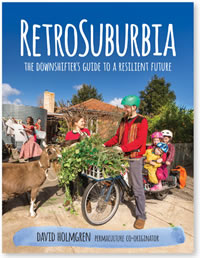 David Holmgren co-created the philosophy of Permaculture while living in Australia in the 1970s. More than just a gardening method, “permaculture could be better described as a design system for resilient living and land use based on universal ethics and ecological design principles.” Holmgren writes RetroSuburbia : the downshifter’s guide to a resilient future from the point of view that the future will become increasingly difficult because of “energy descent” (scarcity) and general global economic depression. However, his tone is optimistic and pragmatic—
David Holmgren co-created the philosophy of Permaculture while living in Australia in the 1970s. More than just a gardening method, “permaculture could be better described as a design system for resilient living and land use based on universal ethics and ecological design principles.” Holmgren writes RetroSuburbia : the downshifter’s guide to a resilient future from the point of view that the future will become increasingly difficult because of “energy descent” (scarcity) and general global economic depression. However, his tone is optimistic and pragmatic—
he has led a self-reliant life and so can you. Retrosuburbia is a thick manual with a philosophical foundation for those wishing to be environmentally conscientious, resilient and self-reliant. Holmgren distills the rationale of his guide as: “… downshifting away from consumption supported by paid work and debt to a culture of voluntary simplicity and permaculture productivity.”
The book is divided into three fields: built, biological, and behavioral. Each discussion point draws from 12 permaculture design principles. such as “integrate rather than segregate” and “use and value diversity.” These principles have a corresponding icon that is included every time the principle is invoked.
One chapter in the Build section is “Warm in Winter, Cool in Summer,” which explains house retrofitting methods to reduce reliance on gas and electric heaters and air conditioners. Common sense measures to reduce drafts and improve insulation are mentioned. Holmgren also details more creative techniques such as building attached greenhouses on the sunward side for passive solar winter gains. In the summer, the greenhouse would grow vines like beans or tomatoes to block the sun from over-heating the main house. Growing deciduous trees or vines on the west side of the house also moderates summertime indoor temperatures. And like fathers everywhere, Holmgren reminds us to put a sweater on if we’re cold in the winter.
The chapter “Building and Maintaining Soil Fertility” is in the Biological Field section. The introduction to soil management for food production is general and discusses how suburban soil fertility is different than conventional agriculture and how modern practices like city composting programs make it relatively easier for home farmers to improve backyard soils. Holmgren highly recommends professional soil testing and gives an example from his own garden of how soil minerals can get out of balance with direct negative impacts on trees and crops. The rest of the chapter discusses various fertility generating techniques in general terms and when they might be appropriate to use. No details or instructions are given, but the heavily foot-noted text gives numerous suggestions for further reading.
The Behavior Field section covers topics such as “Transport and Travel,” “Creating Your Own Livelihood,” and “Financial Planning and Security.” Each chapter encourages a re-framing of how to spend time and money. One suggestion in the financial planning chapter is to invest in small, local business that will directly contribute to community resilience, like a wind farm or urban farm. There is also discussion of which trade-able goods might be worth stockpiling and the relative pros and cons of having cash on hand. Holmgren questions the wisdom of borrowing to pay for a university education that leaves graduates deep in debt, but without skills of self-reliance.
The book will be instructive for people concerned about the climate crisis, those wanting to be self-sufficient and even those on a path to FIRE (Financial Independence, Retire Early). There are no suggestions to head for the hills and retreat from society, but instead Holmgren instructs readers how to retrofit urban and suburban developments to support growing food and meeting life’s necessities while transitioning away from conventional modes of employment and consumption.
Published in the January 2020 Leaflet, Volume 7, Issue 1